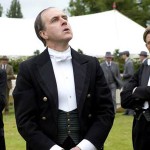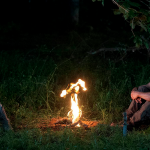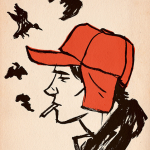This past weekend, I attended the Midwestern Regional Meeting of the Conference on Christianity and Literature, held at Wheaton College (which also happens to be my alma mater). The theme of the conference was “The City,” and over the course of three days, panelists and attendees discussed both the representation and the influence of the city in literature, from ancient works to post-9/11 fiction. I’ll share here a few of the insights gained from my fellow panelists and speakers. Some of the discussions are definitely geared towards literature scholars, but I also hope there will be moments of interest for anyone who cares about the points of conjunction and conflict between the Earthly City and the City of God. (See Part 1 of this two-part post.)
Friday, September 25 and Saturday, September 26, 2009
“‘Vapour, shadow, smoke, and confusion’: Advice for Surviving the Hypocrisy of Bath from Jane Austen and Joanna Baillie”–Christine Colón, Wheaton College
It is a truth universally acknowledged that Jane Austen hated the city of Bath: the first part of this presentation’s title is from a description of Bath that Austen penned in a letter. As far as Austen’s fiction, Bath served primarily as a refuge for her disreputable characters. In Northanger Abbey, the young naïve protagonist, Catherine Morland, while sojourning with family friends in Bath, has to learn to judge others’ characters aright. Catherine’s reading of Gothic novels definitely affects how she “reads” other people, often in humorous ways. Colón argues that both Austen and her contemporary, Scottish playwright Joanna Baillie, suggest that the solution to the hypocrisy of Bath may lie in the power of literature to educate and transform readers. According to Colón, Austen, even more than Baillie, asks readers to engage in an active and continual process of interpretation. Austen will not let us remain content to view Catherine as a stereotype; we continually have to revise our opinion of her. Austen doesn’t leave it there, however: as readers, we have to learn to revise our judgment of ourselves as well. Colón here mentions a prayer of Austen’s overheard by her sister: “teach us to understand the selfishness of our own hearts.” Reading yourself and others accurately, then, is a major part of Austen’s Christian ethic.
“Quomodo sedet sola civitas: A Lonely Faith, Homosexuality, and Mourning in Andrew Holleran’s Grief” Jacqueline Padgett. Trinity University (Washington, DC)
The first part of Padgett’s title is from the opening of the Vulgate text of Lamentations: its English translation is “How lonely sits the city.” Lamentations refers to the destruction of Jerusalem; Andrew Holleran’s 2006 novella Grief refers to Washington, DC, in the wake of death in the gay community from the 1980s AIDS epidemic. The narrator likens the city to a tomb, and another character mentions having lost between 300 and 600 friends to AIDS. Holleran is a gay Catholic writer who, in spite of the Catholic Church’s position on homosexuality, does not engage in anti-Catholic tirades. In the novel, the narrator loses both his faith in God and his faith in homosexual love, referring to this loss as a “double loneliness.” In the end, the narrator rejects the city as a place where love is lacking, and he returns to his parents’ home in Florida, where he finds himself once again able to pray. Given this turn, Padgett points out that there are often similarities in form between Christian conversion narratives and gay/lesbian narratives. I particularly appreciated Padgett’s presentation because I think it’s important for Christians to seek understanding of how gay writers relate to faith, whether we agree with their conclusions or not. Drawing a point from the previous presentation on Austen, I might even argue that reading works by gay writers might not only help to increase our compassion, but also help us learn to judge ourselves—and the selfishness of our own hearts—rightly.
“Finding the Place Unsatisfactory: T. S. Eliot, the Underground, and St. Mary Woolnoth’s Crypt”–Josh Mabie, University of Minnesota
Mabie’s presentation was a fascinating bit of cultural history about St. Mary Woolnoth, a church that receives brief mention in T. S. Eliot’s The Waste Land:
Unreal City,
Under the brown fog of a winter dawn,
A crowd flowed over London Bridge, so many,
I had not thought death had undone so many.
Sighs, short and infrequent, were exhaled,
And each man fixed his eyes before his feet.
Flowed up the hill and down King William Street,
To where Saint Mary Woolnoth kept the hours
With a dead sound on the final stroke of nine.
This representation of the church as dead and barren contrasts dramatically with its history of evangelical social action in the days of John Newton (who preached there for 27 years) and William Wilberforce. In the late 19th century, squeamish Victorians undertook the project of removing the bodies from the church crypt, because their smell and noise was offensive. After this memento mori was removed, the bell of St. Mary Woolnoth was emptied of its sacred significance as well: by the time Eliot writes The Waste Land, the bell merely reminds the poem’s speaker that it’s 9:00 a.m. and he has to get about the day’s business. Though I’m not terribly fond of bones myself (Charnel house in the Egyptian desert? Been there, done that, never want to smell it again.), I’ve found myself thinking ever since Mabie’s presentation of how, in contemporary Western culture, we work so hard to isolate ourselves from death. Might this be a contributing factor to why, like Eliot’s narrator, we feel so dead while alive? In a church setting, especially, we shouldn’t fear to remind ourselves of death, since we have the promise of resurrection—even for old, smelly bones.










